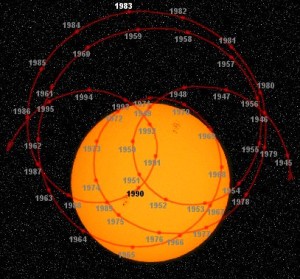In long-running disputes, sometimes it’s good to get back to basics. A recent exchange with an enquirer highlighted yet again the inability of the new geocentrism to stand on its own two feet when confronted with the most basic challenge.
My interlocutor asked for a simple explanation why geocentrism is not viable as a scientific viewpoint. Before laying out that simple explanation, I made just one stipulation – the geocentric counter-reply must make no appeal to General Relativity (GR). That stipulation was necessary because I knew that would be the first place they’d go. Geocentrists get lots of mileage out of a bogus appeal to GR, deploying various claims along the lines of “General Relativity allows for geocentrism” or “See, even famous scientists X and Y agree that geocentrism is plausible” (see, for example, “Context Anyone? The (Literally) Incredible Geocentrists Strike Again”.) This rhetorical ploy has been effective in bamboozling some people into thinking that geocentrism actually has the support of modern science and scientists.¹
 But the appeal to General Relativity by the geocentrists is illegitimate. Why? Because the geocentrists are the ones making the truth claim that the Earth is the exact center and is motionless. They insist that it is the one, absolute frame of reference. The new geocentrists vociferously reject General Relativity, which inherently excludes the concepts of an absolute center and absolute rest (for evidence of their rejection of GR see here). It does not take a rocket scientist to understand that one may not both reject a theory and simultaneously appeal to it in order to prop up one’s own view. This is what Dr. Alec MacAndrew has dubbed the Great Inconsistency at the very heart of the new geocentrism. He writes:
But the appeal to General Relativity by the geocentrists is illegitimate. Why? Because the geocentrists are the ones making the truth claim that the Earth is the exact center and is motionless. They insist that it is the one, absolute frame of reference. The new geocentrists vociferously reject General Relativity, which inherently excludes the concepts of an absolute center and absolute rest (for evidence of their rejection of GR see here). It does not take a rocket scientist to understand that one may not both reject a theory and simultaneously appeal to it in order to prop up one’s own view. This is what Dr. Alec MacAndrew has dubbed the Great Inconsistency at the very heart of the new geocentrism. He writes:
Surely it is deeply inconsistent and illogical to invoke physics in support of their claims that they think is wrong-headed, atheistically motivated, a product of the author’s moral degeneracy and medical ailments, and amounting to no more than science fiction – to do so smacks of desperation. (“Here Comes the Sun”, p. 17).
And:
Now an honest scientist who rejects a particular theory, doesn’t turn round in the next sentence and use it to support his case – by rejecting it, he is proclaiming that it is not a good description of reality, so how can he logically and fairly use it in support of his idea, which presumably he believes does reflect reality? Of course he can’t – or shouldn’t. The fact that the neo-geocentrists rely on a theory they detest and reject is the fundamental Great Inconsistency at the heart of neo-geocentrism that has always been there and that they have never succeeded in resolving (“There He Goes Again”, p. 2).
General Relativity (GR) inherently excludes an absolute center and absolute motion. The new geocentrists vociferously reject GR (again, see here.) In order to avoid the Great Inconsistency, the geocentrists must lay aside any and all reference to General Relativity. Their view needs to stand on its own two feet. It is their burden to show how their own theory is viable on its own, given the evidence that we have. And that’s where it all falls apart for them.
S trict geocentrism was rejected by all working astronomers and physicists many decades before General Relativity or Big Bang cosmology came on the scene. And it’s pretty safe to say that it will continue to be rejected even if those theories are supplanted by other theories. Why? Because in order to be viable, scientific theories must be backed by observational evidence. Can geocentrism stand on its own, with no appeal to GR? Can it provide observational evidence to answer to even the most basic questions? No.
trict geocentrism was rejected by all working astronomers and physicists many decades before General Relativity or Big Bang cosmology came on the scene. And it’s pretty safe to say that it will continue to be rejected even if those theories are supplanted by other theories. Why? Because in order to be viable, scientific theories must be backed by observational evidence. Can geocentrism stand on its own, with no appeal to GR? Can it provide observational evidence to answer to even the most basic questions? No.
As Dr. MacAndrew has laid out well in “Here Comes the Sun: How the Geocentrists Persist in Scientific and Logical Errors”, the gravity of the Sun dominates our solar system. The scientific explanation for why the Earth does not fall into the Sun is that it is orbiting the Sun, just like the other planets. And this means that it’s moving and that it’s not the center even of our solar system, let alone of the entire universe.
The only other way this could work is if there were some other masses that perfectly and continuously offset the Sun’s enormous gravitational influence on the Earth. And this is where the geocentrists think they have an “out” – they say our problem is that we’re looking at our solar system in isolation without regard to the influence of the rest of the bodies in the universe. Robert Sungenis states, “each night we see that there are countless stars the [sic] circle the Earth. Each of those 5 sextillion stars have gravity, and that gravity will affect how the Sun and Earth react to one another, especially if the Earth is put in the center of that gravity” (“Karl Keating’s “Scientific” Attempt to Debunk Geocentrism”, p. 2). So according to him it’s the gravity of the “5 sextillion stars” that keeps the Earth from plunging into the Sun. But this raises two insuperable problems.
First, because of the extreme distances involved, the distant stars and galaxies simply do not provide enough gravitational influence to offset the nearby Sun’s gravity. As Dr. MacAndrew demonstrates in his paper, even if you put all of the galactic clusters that lie within 2.5 billion light years on one side of the Earth and positioned them much closer than they actually are, their combined gravitational pull would still be, “30 million times less than the Sun’s gravitational field at the Earth” (see “Here Comes the Sun”, p. 5).
And the geocentrists have a second, even more serious problem. Not only is the gravitational field of these distant masses not remotely sufficient, but in order for them to exactly offset the Sun’s (and to a lesser extent the Moon’s and other planets’) gravitational fields, these offsetting masses would have to be moving constantly and be positioned perfectly at every second of every day of every year in order for the Earth to remain motionless. This has been laid out very well with some nice visuals by Gary Hoge in “As the Universe Turns”.
There is no observational evidence whatsoever that the other bodies in the universe are constantly moving in the precise way necessary to offset the Sun’s enormous gravity.
When recently confronted yet again with this conundrum, geocentrist Rick DeLano followed two predictable paths. First, he immediately appealed to (drum roll….you guessed it!) General Relativity, even though he rejects General Relativity and even though I explicitly stated that such an appeal was off the table, for the obvious reasons I gave above – he rejects General Relativity so he can’t appeal to it. And, in any case, the concepts of absolute rest and an absolute center are excluded in General Relativity, so an appeal to it explicitly destroys his argument. Second, he lapsed into ridicule and insult (and just as I was about to direct the reader to this exchange, I find that that my interlocutor appears to have taken it down.)
What he did not do is answer the question. What is the observational evidence for masses in the universe that, at every instance of time, offset the enormous gravitational pull of the Sun and planets in our solar system? On that question, DeLano was completely silent.
So here’s the bottom line: For geocentrism to be viable, the geocentrists would have to provide observational evidence for both the existence of and precise motion of masses that at every instant of time are positioned perfectly to offset the enormous gravity of the Sun and other planets, thus leaving the Earth motionless.
There is no such observational evidence. Therefore, geocentrism is not a viable scientific theory. That is why the geocentrists don’t have the support of a single working astronomer or physicist. As a scientific theory providing a coherent explanation for what we observe, geocentrism falls flat.
It really is just that simple. But it shouldn’t come as a surprise. This is what happens when you turn the scientific method on its head. Modern geocentrism amounts to faulty theology, dictating unshakable “scientific” conclusions, in search of supporting evidence.
End Notes:
¹ Rather than rehash all of the myriad problems in the neo-geocentric appeal to General Relativity here, I would bid the reader carefully read “Here Comes the Sun: How the geocentrists persist in logical and scientific errors”. Suffice to say that the new geocentrists compound their bogus appeal to GR by simply assuming Mach’s Principle, a conjecture, not a theory which is neither settled nor widely accepted. A reader ignorant of the crucial distinctions can easily be bamboozled by their selective quotes from various physicists. If the neo-geocentrists really think that Mach’s Principle is correct then by all means let them demonstrate mathematically why that must be so!






